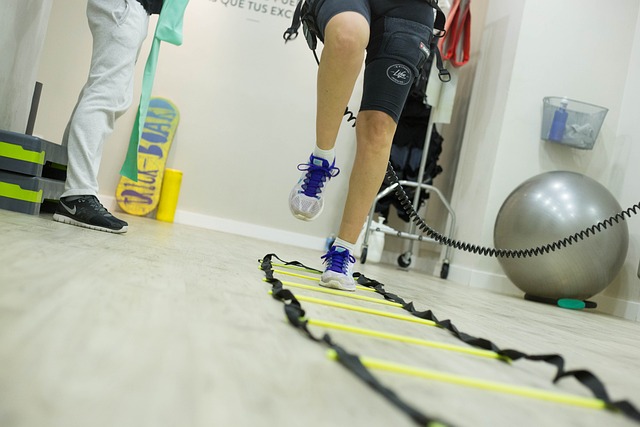To maintain optimal posture at work and enhance spinal health, it's important to integrate a combination of posture correction exercises, such as yoga poses like Cobra Pose and Cat-Cow Stretch, with ergonomic workspace adjustments. Choose an ergonomic chair that supports your spine's natural curves and customize your desk setup to prevent strain on your neck and back. Incorporate alignment therapy, such as chiropractic adjustments, to correct any spinal misalignments and to promote better posture over time. Strengthening your core with targeted routines and engaging in low-impact exercises like Pilates for alignment can further support your posture. Posture support braces can also guide you towards proper postural habits during the transition to a new workspace. By combining these strategies—posture correction exercises, alignment therapy, ergonomic workspace tips, and core strengthening routines—you can create a supportive work environment that encourages sustained good posture throughout the day, leveraging posture and alignment solutions for long-term spinal health benefits.
Navigating the demands of a modern work environment often necessitates a focus on maintaining optimal health and wellness. Among these concerns, posture plays a pivotal role in our overall body alignment and can significantly impact our long-term physical health. This article delves into various strategies to enhance posture at work, from ergonomic workspace adjustments to targeted exercises that fortify the spine and improve core strength. We’ll explore how posture and alignment solutions can be seamlessly integrated into your daily routine, with a spotlight on ergonomic workspace tips to prevent strains and pains associated with prolonged sitting. Additionally, we’ll examine the holistic approach of alignment therapy through chiropractic adjustments and introduce posture correction exercises that can be performed at your desk or as part of a dedicated fitness regimen. For those seeking immediate support, we’ll discuss the benefits and selection process for posture support braces. Whether you’re looking to implement yoga for posture into your life or incorporate Pilates for alignment, this article will equip you with knowledge to make informed choices for a healthier, more balanced you.
- Optimizing Your Workspace for Ideal Posture with Ergonomic Solutions
- – Discuss the importance of proper posture and how an ergonomic workspace can facilitate this.
- – Offer tips on adjusting chair height, monitor positioning, keyboard and mouse placement to promote alignment.
- – Highlight furniture options that support good posture, such as standing desks or ergonomic chairs with adjustable features.
Optimizing Your Workspace for Ideal Posture with Ergonomic Solutions

To achieve and maintain optimal posture at work, it’s crucial to optimize your workspace with ergonomic solutions that support natural alignment. Begin by investing in a quality chair that encourages proper spinal curvature, with adjustable settings for height and tilt. Ensure your desk and computer monitor are positioned to minimize neck strain; the screen should be at or slightly below eye level when sitting. Incorporating posture correction exercises into your daily routine can further enhance alignment. For instance, regular yoga practice, particularly poses that focus on spinal extension and core engagement like Cobra Pose or Cat-Cow Stretch, can significantly improve posture. Additionally, alignment therapy, such as chiropractic adjustments, can realign the spine and alleviate pressure on nerves, promoting better posture over time. Complement these efforts with core strengthening routines that target the abdominal and back muscles, providing a foundation for sustained postural integrity. Pilates for alignment, emphasizing both strength and flexibility, is an excellent choice for those looking to enhance their posture through low-impact exercises. Posture support braces can also be a temporary aid for individuals transitioning into new ergonomic workspace habits, offering physical guidance to correct slouching tendencies. By integrating these ergonomic workspace tips and therapeutic practices, you can create a work environment that supports and encourages better posture throughout the day.
– Discuss the importance of proper posture and how an ergonomic workspace can facilitate this.

Maintaining proper posture at work is pivotal for long-term spinal health and overall well-being, as it can prevent a multitude of musculoskeletal disorders. An ergonomic workspace, tailored with specific solutions for posture and alignment, plays a significant role in supporting this aspect. Adjustable chairs, desks, and monitor stands are key elements that allow individuals to customize their environment for optimal body positioning. Incorporating posture correction exercises, such as those derived from yoga or pilates, into daily routines can further enhance spinal alignment and core strength, which in turn provides a solid foundation for good posture. Additionally, alignment therapy and chiropractic adjustments can offer targeted interventions to correct misalignments and improve posture. Posture support braces can be used as an adjunct to these practices, offering physical guidance and reminding the body of ideal postural positions throughout the day. Core strengthening routines complement these ergonomic strategies by bolstering the muscular framework that underpins good posture, ensuring that the benefits of an ergonomic workspace are sustained over time. Employees should take advantage of these tools and techniques to create a supportive and healthy work environment.
– Offer tips on adjusting chair height, monitor positioning, keyboard and mouse placement to promote alignment.

To enhance your posture and alignment while working, it’s crucial to start with the right chair height. Adjust your chair so that your feet rest flat on the floor, with your thighs parallel to the ground. This position encourages a natural curve of the spine, reducing strain on your back muscles. Next, consider your monitor’s placement; it should be at or slightly below eye level to prevent hunching over. Position it arm’s length away to minimize neck tension. For your keyboard and mouse, ensure they are directly in front of you, allowing your arms to rest by your sides with elbows at a 90-degree angle. This ergonomic setup supports the natural contours of your body, facilitating better posture and alignment without excessive effort.
In addition to physical adjustments, incorporating posture correction exercises into your daily routine can further enhance spinal health. Alignment therapy often includes yoga for posture, which can improve flexibility and strengthen core muscles that support the spine. Additionally, chiropractic adjustments can realign the spine and relieve pressure on nerves, while core strengthening routines and pilates for alignment can target specific muscle groups responsible for maintaining correct posture. Posture support braces can be temporary aids to train your body into better posture habits. By combining these strategies with an ergonomic workspace, you can create a comprehensive approach to achieving and maintaining proper posture at work.
– Highlight furniture options that support good posture, such as standing desks or ergonomic chairs with adjustable features.

Incorporating posture and alignment solutions into your daily routine is pivotal for maintaining optimal spinal health at work. To this end, investing in furniture that supports good posture can make a significant difference. Ergonomic chairs with adjustable features, such as lumbar support and seat depth, allow for personalized comfort and spinal alignment. Standing desks are also gaining popularity, encouraging a more active stance while performing tasks, thereby reducing the risk of developing poor postural habits associated with prolonged sitting. Additionally, integrating posture correction exercises into your workday can further enhance your body’s natural alignment. These exercises often draw from disciplines like yoga and pilates, which are renowned for their focus on core strengthening routines that bolster the back muscles and improve overall posture.
Complementing ergonomic workspace tips with alignment therapy and chiropractic adjustments can provide a holistic approach to posture correction. Alignment therapy, specifically, focuses on assessing and correcting structural imbalances, while chiropractic care can address misalignments and tension in the spine. Regular visits to a chiropractor for spinal manipulations can restore motion to joints that have become locked or limited in movement, contributing to better posture. Moreover, using posture support braces can offer temporary assistance during the healing process or as an aid for those with chronic postural issues. These braces help train the body to maintain proper alignment without relying solely on external support, promoting a stronger and more aware posture over time.
In conclusion, maintaining optimal posture at work is a multifaceted approach that involves strategic ergonomic adjustments and consistent health practices. By implementing our ergonomic workspace tips, individuals can create an environment conducive to ideal posture, utilizing solutions like standing desks and ergonomic chairs with customizable settings. Complementing these physical changes with posture correction exercises, alignment therapy, and regular engagement in yoga and pilates can further enhance postural health. For those seeking additional support, posture support braces and chiropractic adjustments offer targeted assistance. Meanwhile, core strengthening routines serve as a foundational element to bolster overall body alignment. Integrating these practices into daily work life not only promotes well-being but also can significantly improve productivity and comfort, underscoring the importance of a holistic approach to posture management in the workplace.
